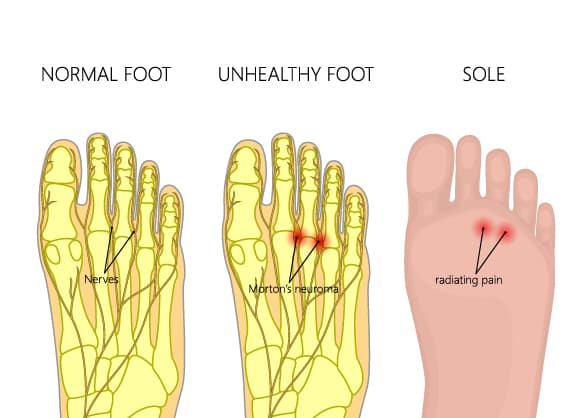
Causing pain in foot and toes
A Morton’s Neuroma (or intermetatarsal neuroma) is a condition in which fibrous tissue forms around a nerve in your foot, compressing and irritating the nerve, causing pain and altered sensation in the foot and toes. The most commonly affected nerve is usually at the base of the 3rd and 4th toes, but it can also affect other nerves in the forefoot.
It is often referred to as an ‘intermetatarsal neuroma’ as the nerve is located in the ball of the foot in between the metatarsal bones and provides sensation to the toes. A Morton’s neuroma may also be accompanied by an intermetatarsal bursa (a fluid-filled sac).
What causes a Neuroma?
There are a number of factors that may contribute to the development of a neuroma, including:
- Abnormal foot posture or foot biomechanics. If you have overly-pronated feet, flat feet or high-arched feet, or a hypermobile (very flexible) foot then this foot type can lead to instability at the forefoot causing nerves to become irritated, impinged and injured.
- Improper footwear – shoes that are too narrow across the forefoot may cause localized nerve impingement. Shoes with high heels will place more weight on the forefoot.
- Activities or Occupations that cause trauma to the nerve – jobs that place undue stress on the forefoot will be more likely to develop a neuroma (eg; working on ladders, flooring / carpeting workers, cleaners etc).
- Repetitive trauma – athletes involved in high impact activities like running, aerobics etc may be more likely to develop a neuroma. Cyclists are prone to this injury due to the forefoot repetitively pushing against the bike pedals / cleats and the use of narrow cycling shoes.


What are the symptoms of a Neuroma?
The most common symptoms of a neuroma include:
- Pain beneath the forefoot and between the toes when weight-bearing
- ‘Pins and needles’ or a tingling numbness in the ball of the foot that radiates into the toes
- A ‘catching’ sensation beneath the forefoot when walking
- Swelling between the toes
- Symptoms are usually more noticeable in firm-fitting narrow footwear or shoes with higher heels.
Symptoms tend to become progressively worse over time as the neuroma enlarges.
How is a Neuroma diagnosed?
Your Podiatrist will take a comprehensive medical history and perform a physical examination and gait analysis. The assessment will include:
- Pain provocation tests – to reproduce your foot pain in order to locate the injured nerve
- Foot posture assessment
- Joint range of motion (flexibility)
- Foot muscle strength testing
- Footwear assessment
- Gait analysis – to look for any abnormalities in the way the feet move during gait
A soft tissue ultrasound may also be recommended.


How is a Neuroma treated?
The primary goal of most early treatment options is to relieve pressure on the injured nerve, allowing it to heal. Your Podiatrist may recommend these treatments:
- Custom Made Orthotics – to improve abnormal foot posture and function. Foot orthotics with specific forefoot padding are very effective at reducing pressure and tension on the affected nerve
- Footwear changes – avoid high heels and tapered toe shoes; avoid overly flexible shoes
- Ice massage – to reduce local inflammation around the nerve
- Activity modification – avoid activities that aggravate the symptoms, until the injury has healed
- Anti inflammatory gel – massaged into the affected area to reduce inflammation around the nerve
- Exercises – to address any foot muscle imbalance or weakness
- Stretching exercises – to improve joint flexibility
- Foot Mobilisation Therapy
- THOR Laser
- Cortisone injections
If your neuroma is large, long-standing or has only partial improvement with conservative care or there is an associated bursitis, your Podiatrist may suggest you have an ultrasound-guided cortisone injection to help settle the localized inflammation about the nerve.
Is Surgery an option?
If the neuroma does not respond to conservative podiatry care, surgery may need to be considered to alleviate your symptoms. Your Podiatrist will liaise with your doctor, to organise a referral to a foot and ankle surgeon.
What should I do if I have a Neuroma?
If you have symptoms of a Morton’s Neuroma, it is best to seek treatment early from your Podiatrist to avoid possible permanent nerve damage and foot surgery. See the experienced Podiatrists in Brisbane Northside for professional advice and treatment.


